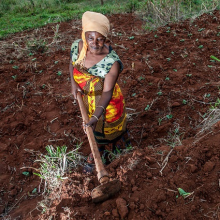
The state of the world’s soils is rapidly deteriorating due to soil erosion, nutrient depletion, loss of soil organic carbon and other threats, but this trend can be reversed if appropriate measures are taken. That is the message of a new UN report released on Friday ahead of World Soil Day which was celebrated on 5th December and marked the end of the International Year of Soils 2015. According to the report, which collects the work of some 200 soil scientists from 60 countries, the majority of soils are in poor or very poor condition and the situation is getting worse. The Food and Agriculture Organisation (FAO) estimates that about 33% of global soils are already moderately or highly degraded due to erosion, salinization, compaction, acidification and chemical pollution. This has serious consequences since soils serve as the basis for the cultivation of crops, filter and clean tens of thousands of cubic kilometres of water each year and sequester carbon, thus helping to regulate emissions of carbon dioxide and other greenhouse gases. “Further loss of productive soils would severely damage food production and food security, amplify food-price volatility, and potentially plunge millions of people into hunger and poverty,” FAO Director-General José Graziano da Silva warned in his foreword to the 650 page-report. The report identifies population growth, urbanization and climate change as the main drivers of soil loss. Soils have been cleared of natural vegetation to grow crops or graze livestock to feed a growing population. Urban sprawl has led to the permanent sealing of soils under asphalt and concrete. Higher temperatures and extreme weather events such as droughts, floods and storms had a negative impact on soil fertility, for example by reducing moisture and depleting the layers of nutrient-rich topsoil. The report highlights ten major threats to soil functions: soil erosion, soil organic carbon loss, nutrient imbalance, soil acidification, soil contamination, waterlogging, soil compaction, soil sealing, salinization and the loss of soil biodiversity. An estimated 760,000 square kilometres of land worldwide – an area larger than all the arable land in Brazil – are affected by human-induced salinity. Soil erosion carries away 25 to 40 billion tonnes of topsoil every year, significantly reducing crop yields and soils’ ability to store and cycle carbon, nutrients, and water. But the authors also offer evidence that the loss of soil resources and functions can be avoided with targeted strategies. Soil erosion can be prevented by reducing or eliminating tillage – digging, stirring, and overturning of soil – and using crop residues to protect the soil surface from water and wind erosion. Nutrients can be restored and yields increased by returning crop residues and other organic material to the soil and employing crop rotation with nitrogen-fixing crops. The solution proposed is one that centres on sustainable soil management and which requires the participation of a broad level of stakeholders ranging from governments to small-holder farmers, FAO said in a press release. (ab)
